This post may contain affiliate links. See my disclosure policy.
The most beloved of all Spanish dishes, Paella is an impressive combination of saffron-infused short-grain rice mixed with meat, seafood, and vegetables. Filled with traditional Spanish flavors, learn everything you need to know about making this delicious, crowd-pleasing Spanish paella recipe.
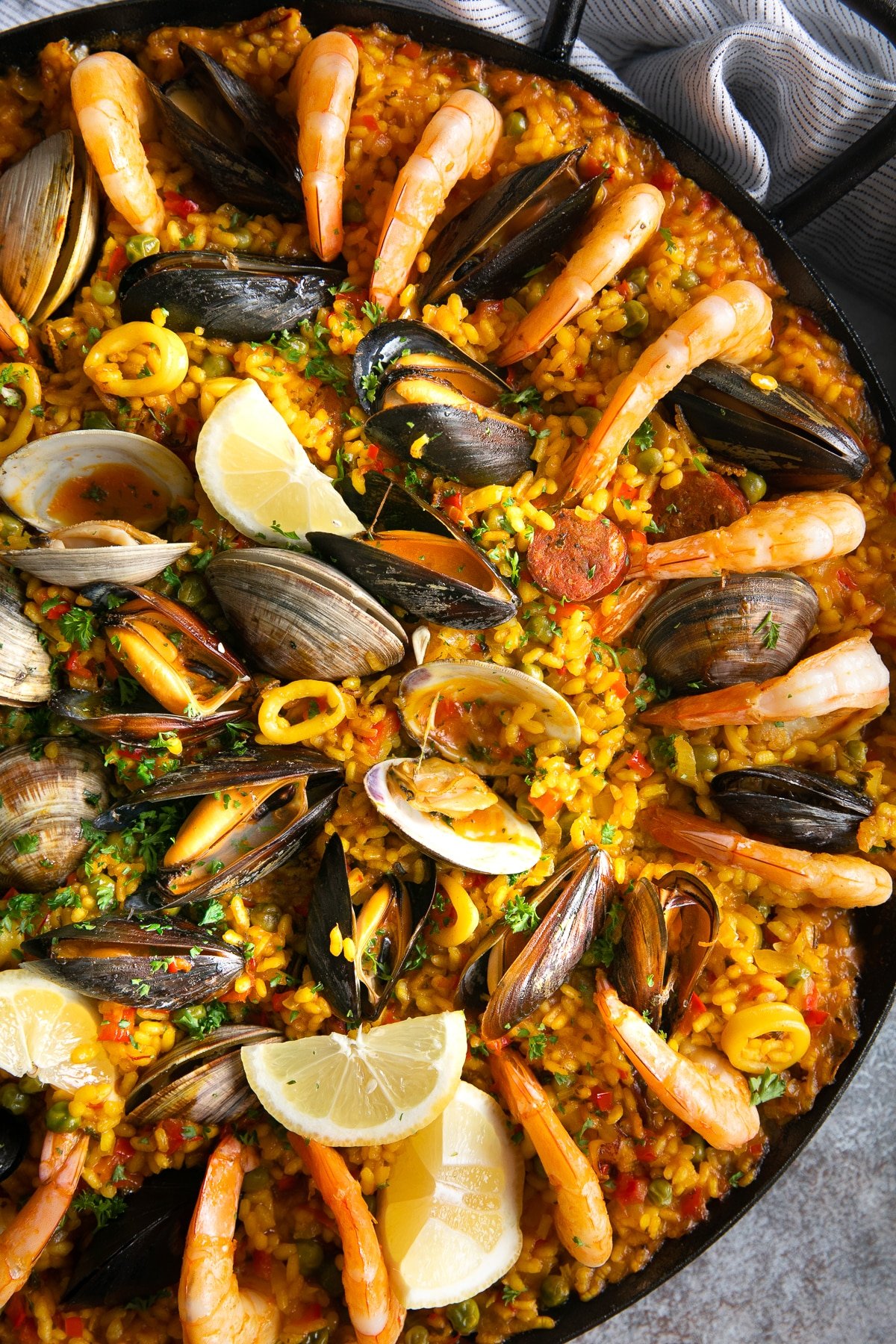
A Mixed Paella Recipe
I vividly remember the first time I ever experienced paella. Circa 2010, I had just landed in Spain with my boyfriend (now husband) for my first ever European holiday. It was also lunchtime. So, bags in low, we stopped to get paella. A dish completely unknown to me, it was all my husband could talk about for the weeks leading up to our trip. When I asked what it was he would say, “don’t worry, you’ll love it. It’s rice and seafood”.
And, in a nutshell, I suppose that, yes, that is paella. But the truth is that this Spanish dish, a must-experience for all who travel to Spain, is so much more than just rice and seafood and a pan. In fact, seafood didn’t even make its way into paella recipes until it made its way to the coast.
Anyway, I’m getting ahead of myself. Let’s start from the beginning…
Table of Contents
What is Paella?
Paella (pai·ei·uh) is a classic rice dish originally from the Valencian region of Eastern Spain. A major cultivator of rice since it was introduced to Spain by the Moors in the 10th century, Valencia was one of the largest trading ports in the Mediterranean.
It is believed that the original paella, paella Valenciana, consisted of short-grain rice plus whatever was on hand or leftover. This often included water vole (a type of water rodent), eel, and butter beans. Originally, paella would have been enjoyed by farmers and laborers as a lunchtime meal.
As living standards started to improve throughout Spain in the late 19th century, paella ingredients started to change with it. The most widely used ingredients at that time included – short-grain rice, chicken, snails, duck, rabbit, green beans, tomatoes, great northern beans, runner beans, artichoke (a substitute for beans in the winter), fresh rosemary, paprika, saffron, garlic, olive oil, and water.
RELATED: Jambalaya Recipe (How to Make Jambalaya)
Variations
There are countless numbers of paella recipes and varieties. Here are 3 of the most popular.
- Paella Valenciana: As mentioned previously, paella Valenciana is believed to be the original recipe. Traditionally made with a mix of simple vegetables, short-grain rice, snails, and other meat including rabbit, duck, or chicken. Butter beans or lima beans were a common addition as well as saffron for special occasions.
- Paella de Marisco (Seafood Paella): Also known as Paella Marinera when it contains more than 5 different seafood ingredients. This version does not contain any meat. Typically it’s filled with prawns, mussels, calamari, clams, salted cod, scallops, and other types of seafood. Sometimes referred to as arroz caldoso, or “soupy rice” because all the juices from the seafood add liquid to the paella.
- Paella Mixta: A fusion of paella Valenciana and paella de marisco, these versions (as there are many) contain various types of meat and seafood. Despite regional differences, salt, saffron, and garlic are almost always added.
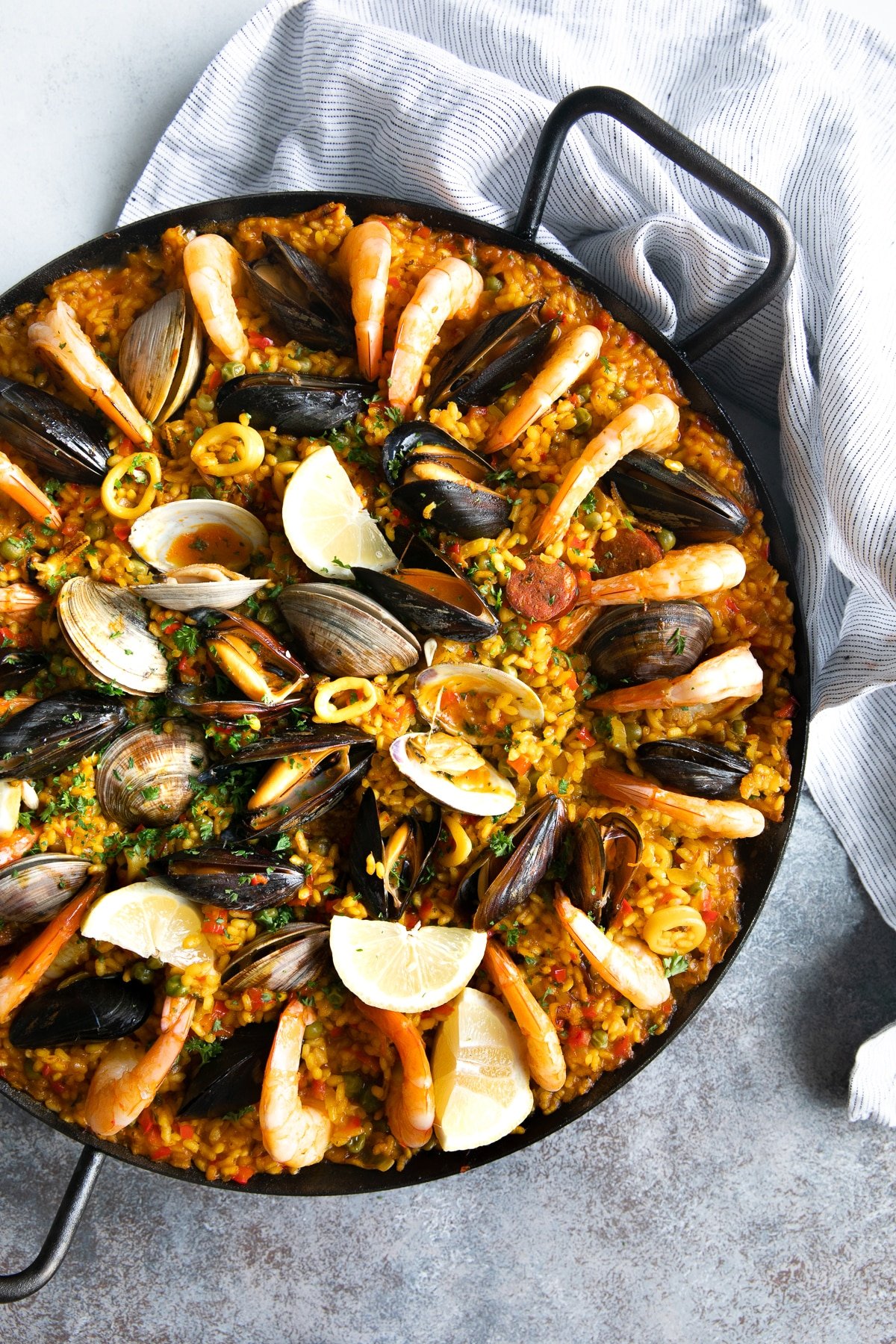
Paella: Pan and Rice
The pan
In Valencian, Valencia’s regional language, paella or la paella means “frying pan”. This pan, or paella, is so important, that this was how paella got its name.
What makes a paella pan unique? It is a wide, shallow, and round pan with splayed sides. It has two looped handles and does not have a lid. The shape helps ensure that the rice cooks in a thin layer, which, according to several Valencians, should be no more than the width of about one finger (or 1/2 an inch). In order to create the highly sought-after Socarrat – a crispy, golden crust on the bottom of the pan – it’s key to maximize the amount of rice touching the bottom of the pan. For this reason, paella pans grow in diameter, not in height.
Do I need a paella pan?
No, you may use a regular 12-inch skillet, however, I would recommend cutting the recipe in half as everything will not fit into a pan that size.
The Rice
In addition to the pan, you need to use the right rice.
Spanish rice is rounded and short. It’s quite starchy and absorbs more liquid when compared to regular rice without turning mushy. Bomba rice is an overwhelming favorite, but other great rice options include Calasparra rice and Valencia rice).
Some people have success with arborio rice (the rice used to make risotto) or long-grain white rice, but I don’t recommend either of those. Calrose rice, widely available at most grocery stores, is the best substitute. Should you use this rice, decrease the total cooking liquid to 4 cups.
RELATED: Different Types of Rice: Varieties and What to Do With Them
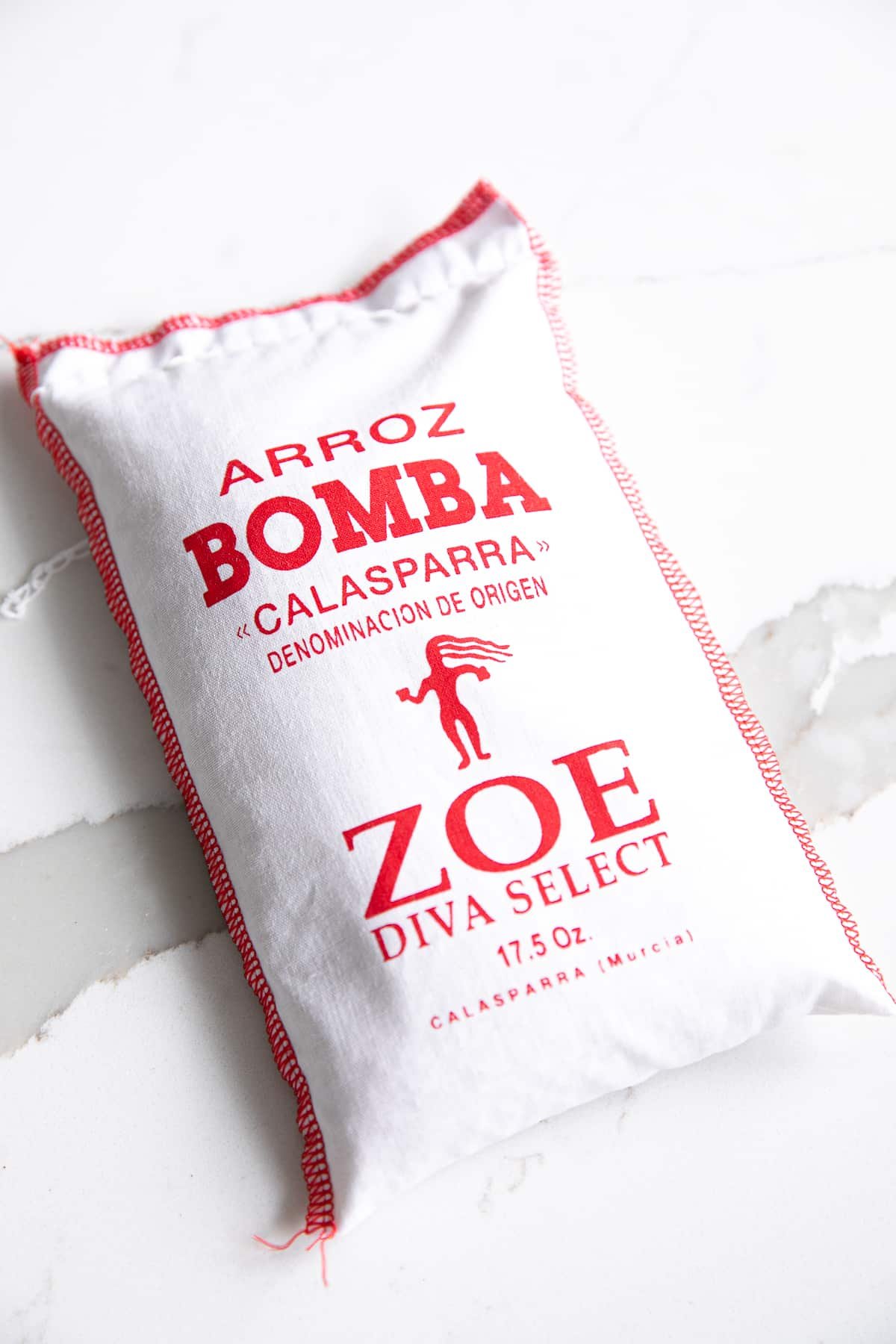
Ingredients
It is hotly debated whether sausage should be added to paella. Many people have very strong feelings that it should not, under any circumstance, be added to any paella recipe. Others, on the other hand, argue otherwise. I recall enjoying a very large pan of paella filled with Spanish chorizo and seafood while in Spain, so I say do what you want.
To make this recipe you will need the following:
- Shrimp (shells reserved to make homemade stock)
- Seafood, shrimp stock, or clam juice
- Low-sodium chicken broth
- Dry white wine
- Saffron
- Extra virgin olive oil
- Sofrito (onion, red pepper, garlic cloves, tomatoes)
- Spanish chorizo
- Sweet paprika
- Rice
- Green peas
- Additional seafood (calamari, mussels, clams)
- Fresh lemons
- Fresh parsley
Saffron is a spice derived from the flower, crocus sativus – also known as the “saffron crocus”. The delicate crimson-colored stigma and styles, called threads, are collected from the crocus sativus, dried and used as a seasoning and natural food coloring. Most of the world’s saffron is grown in Iran, Greece, Morocco, and India. Saffron is widely available from many major grocery stores and also sold online (take care to buy from a reputable source).
This recipe makes approximately 4-6 main course servings. While I cooked this recipe in a 15-inch paella pan, I recommend using an 18-inch pan for best results.
Spanish chorizo is made from chopped pork and pork fat and seasoned with garlic, smoked paprika, and salt. Generally available as either Picante (spicy) or dulce (sweet), depending upon the type of paprika used. If you can’t find any Spanish chorizo, try using a different smoked sausage, like Andouille sausage, as it is already cooked.
Chicken is a very popular addition to mixed paellas. To cook, chop boneless chicken thighs or a large chicken breast into small pieces and brown in a little olive oil either before or after you sauté the sausage. Remove and set aside to rest until you add back to the pan at the same time as the sausage.
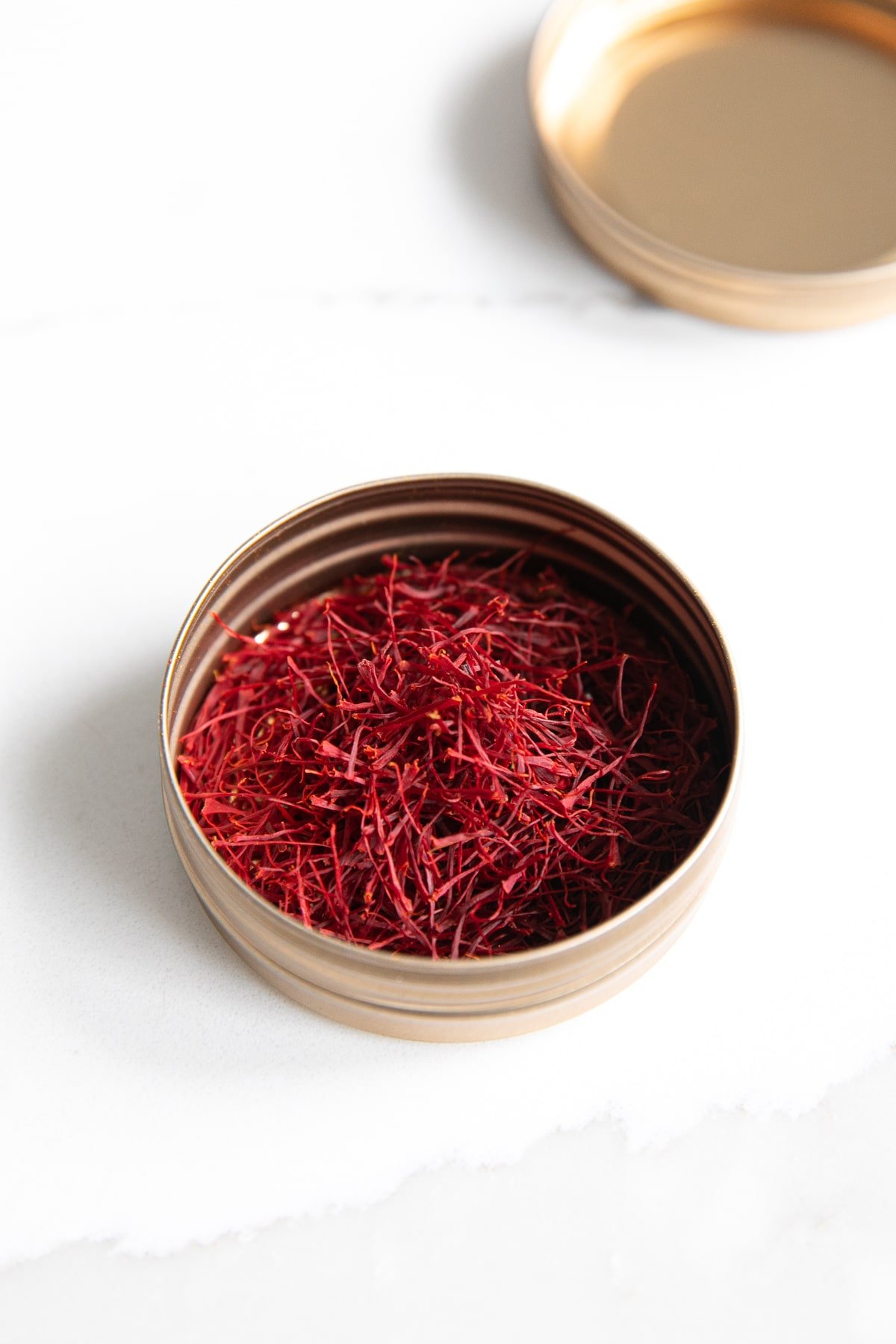
How to Make Paella
I would like to note that this is just one of many hundreds of versions of paella. While featuring many common and “authentic” Spanish flavors and ingredients, I am aware that it may not be considered a traditional paella by some of you out there. Please, if you are the owner of such a recipe, I’d love to see it.
1. Make your homemade shrimp stock (optional): If your shrimp are frozen, thaw them. Remove shells and tails (or leave tails on – up to you) and transfer the shrimp to a large bowl. Set aside in the refrigerator until ready to use. Add the shells, onion, smashed garlic, and bay leaves to a large pot filled with at least 4-5 cups of water. Bring to a boil and simmer for at least 45 minutes. Strain through a fine-mesh strainer and set aside.
2. Herb blend: As the broth is simmering, combine the chopped Italian parsley, fresh lemon juice, olive oil, and garlic in a small bowl. Set aside.
3. Combine and simmer stock with saffron: Transfer 4 cups homemade (or store-bought) shrimp stock (or clam juice, or seafood stock) to a medium saucepan with 2 cups chicken stock and one cup white wine. Bring to a gentle simmer, reduce heat to low, and add the saffron.
4. Peel and devein the shrimp (if you haven’t done so already), leaving the tails on, or removing them (up to you). Set aside, you’ll need them in a sec.
5. Brown the sausage and cook the shrimp: Heat a bit of olive oil in your pan and cook the sausage for 2-3 minutes. Remove to a clean plate and add the shrimp. Cook for 1-2 minutes on each side, or until nearly cooked. Remove to a clean plate and set aside.
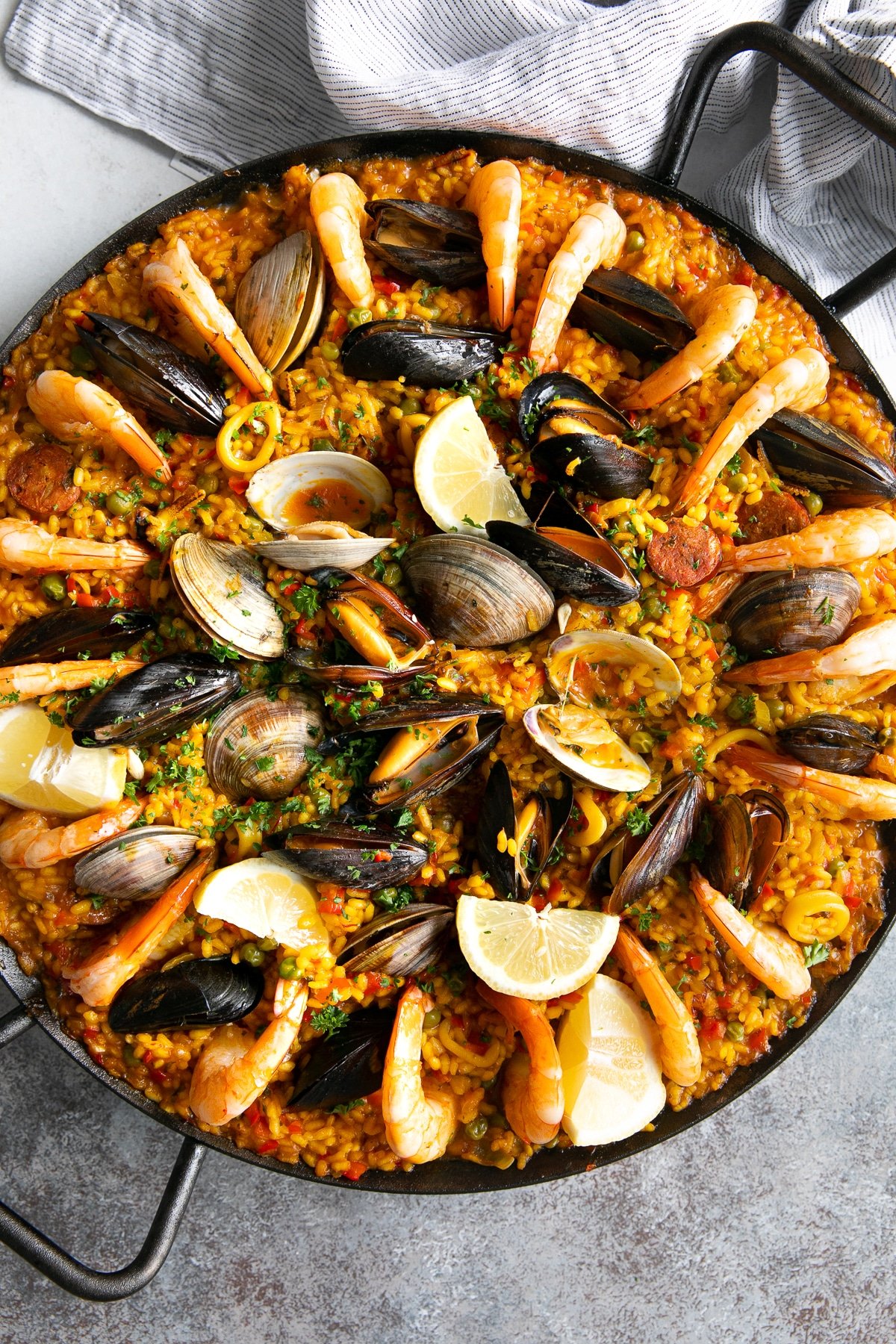
6. Cook the sofrito over medium heat: Add an additional tablespoon of olive oil and add the onion and bell peppers. Cook, stirring occasionally, for 10-15 minutes. Rotate the pan as needed to ensure even cooking. Add the salt and garlic, cook for an additional minute. Add the diced tomatoes, sweet paprika, and thawed (drained) calamari. Cook, stirring often, for an additional 3-5 minutes.
7. Toast the rice. Combine the rice with the aromatics. Cook, stirring often, for 1-2 minutes.
- Typically I tell you to wash your rice. In this case, do the opposite and do not wash your rice.
8. Add the herb mixture, thawed peas, sausage, and broth. Mix thoroughly to combine. Bring to a boil, then reduce heat to medium-low. As the mixture comes to a boil, stir as needed to combine the rice with the meat and vegetables. Stir for 5 more minutes then stop stirring for the remainder of the cooking time.
9. Cook, uncovered for 15 minutes.
10. Nestle the clams, mussels, and shrimp into the rice mixture. Cook for 5-10 minutes, or until shells open (discard any unopened shells). Rotate the pan every few minutes to ensure even cooking.
11. Garnish and serve: Remove from heat, drizzle with fresh lemon juice, and cover with a towel. Allow paella to rest for 5-10 minutes before serving. Garnish with fresh parsley and lemon wedges, if desired.

Leftovers
Store any leftovers in a sealed container in the refrigerator for up to 4-5 days. Seafood such as clams, shellfish, and calamari are best enjoyed the same day they’re cooked as they do not reheat well.
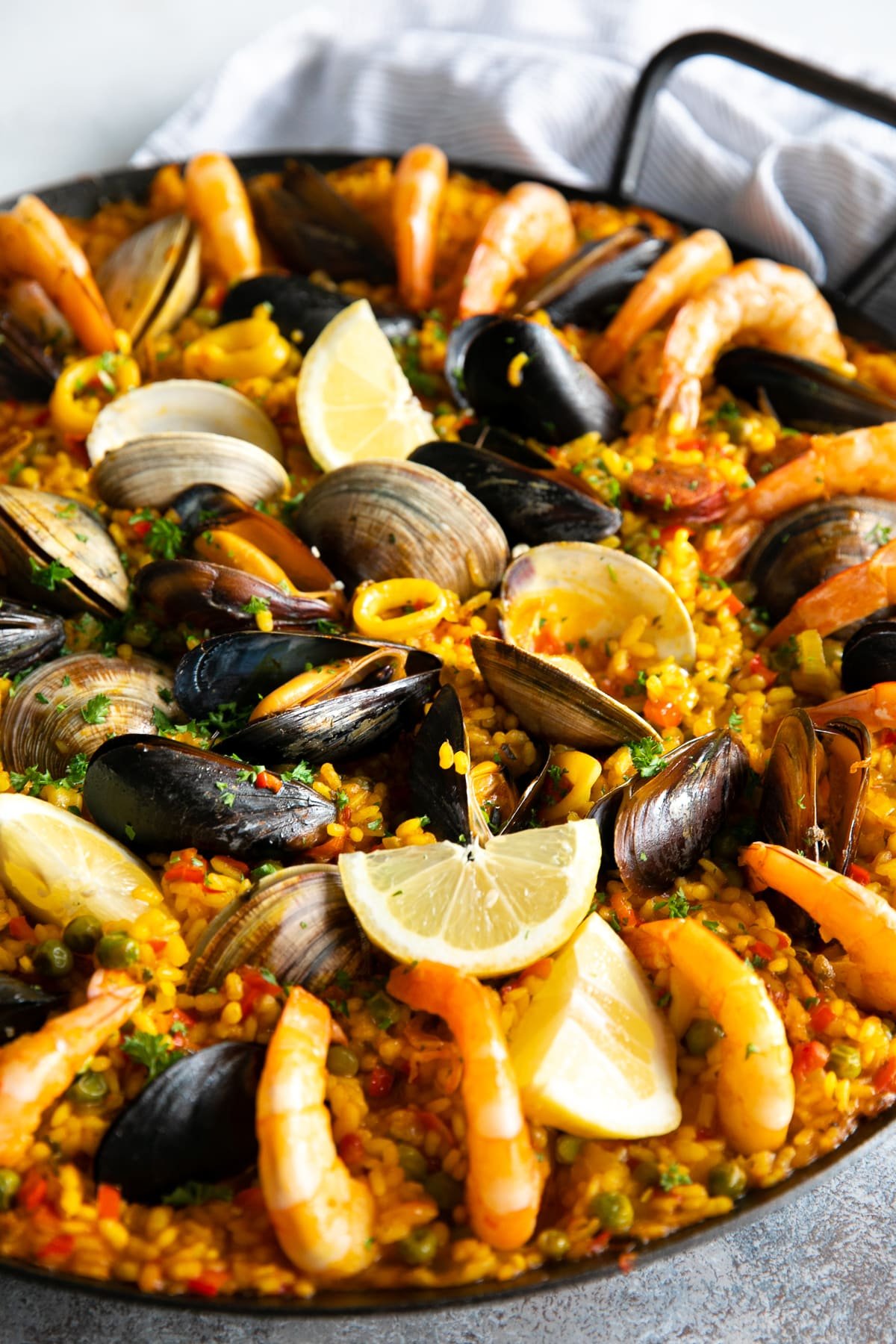
More Rice Recipes,
Arroz Caldo Recipe (Filipino Chicken and Rice Porridge)
How to Cook Perfect Rice on the Stove
Coconut Rice Recipe (How to Make Coconut Rice)
If you try making this Mixed Paella Recipe, please leave me a comment and let me know! I always love to hear your thoughts.
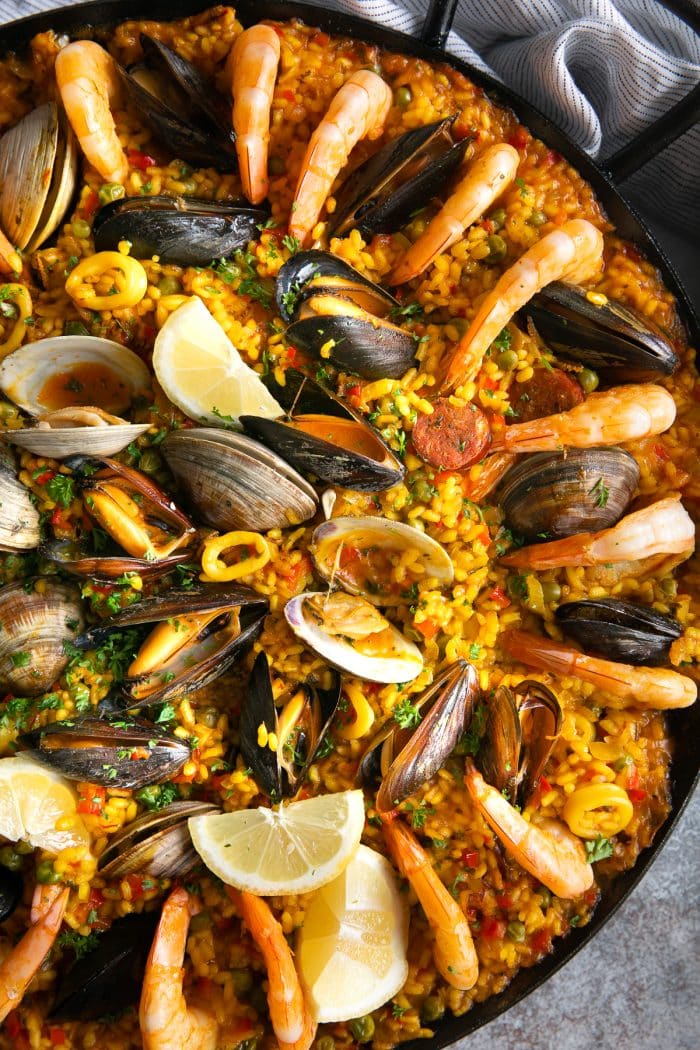
Paella Recipe – How to Make Spanish Paella
Ingredients
For the Shrimp Stock (optional – see notes)
- Shells from at least 1 pound of shrimp
- ½ medium onion, roughly chopped
- 2 cloves garlic, smashed
- 3 large bay leaves
- 5 cups water
For the Herb Blend
For the Paella
- 4 cups homemade shrimp stock, (or low-sodium chicken broth or store-bought clam juice or seafood stock)
- 2 cups low-sodium chicken broth
- 1 cup dry white wine, (or additional shrimp or chicken stock)
- 1 teaspoon saffron threads, (approximately 1 gram)
- 2 tablespoon olive oil
- 2 links (approx. 7 ounces) Spanish chorizo, cut into 1/2-inch slices
- 1 pound jumbo shrimp, peeled and deveined
- 1 large onion, finely diced
- 2 red bell peppers, finely diced
- 5 cloves garlic, minced
- 1 teaspoon salt
- 1 cup diced tomatoes, (canned or fresh)
- 1 teaspoon sweet paprika
- 3 cups uncooked Paella rice, (bomba rice, Valencia rice, Calasparra rice)
- 1 cup frozen green peas
- 1 pound calamari, thawed
- 1 pound mussels, scrubbed
- 1 pound short-neck clams
- lemon wedges, for serving
Instructions
- To make homemade shrimp stock: this step is optional but absolutely worth it (especially if you purchased shrimp with the shells and tails left on).
- Start by thawing the shrimp (if frozen). Remove shells and tails (or leave tails on – up to you). Transfer the shrimp to a large bowl and set aside in the refrigerator until ready to use. Meanwhile, add the shells to a large pot. Add the roughly chopped onion, smashed garlic, and bay leaves. Fill with at least 4-5 cups of water.
- Bring to a boil over high heat before reducing to low heat. Cover and simmer for 45-60 minutes. Strain the broth through a fine-mesh strainer into a separate pot or container. Measure out the desired amount (I used 4 cups).
- Prepare the herb blend by combining the chopped parsley, fresh lemon juice, olive oil, and garlic in a small bowl. Mix to combine and set aside.
- Combine your stock. Once your homemade shrimp stock has been strained and measured, transfer the desired amount (in my case, I used 4 cups) to a medium stockpot with 2 cups chicken broth and 1 cup white wine (you need 7 cups of liquid total). Bring to a gentle simmer over medium heat. Add the saffron, mix well to combine, and reduce heat to low. Cover and gently simmer until needed.
- Peel and devein the shrimp (if you haven't done so already), leaving the tails on, or removing them (up to you). Set aside, you'll need them in a sec.
- Heat 1 tablespoon of olive oil in a large paella pan over medium-high heat. Add the sliced sausage and cook for 2-3 minutes, stirring as needed (see notes). Remove from pan to a clean plate. Set aside.
- Add the shrimp to the pan (add additional olive oil, if needed). Cook shrimp for 1-2 minutes on each side, or until nearly cooked. Remove from the pan to a clean plate. Set aside.
- Reduce heat to medium. Add one more tablespoon of olive oil and add the onions and bell pepper. Mix thoroughly to combine. Cook, stirring often, for 10-15 minutes. Add the salt and garlic, cook for an additional minute before adding the diced tomatoes, sweet paprika, and thawed (and drained) calamari. Cook, stirring often, for an additional 3-5 minutes.
- Add the dry rice to the pan and mix thoroughly with the aromatics. Allow the rice to toast for 1-2 minutes, stirring occasionally.
- Add the herb mixture, thawed peas, sausage, and slowly add the broth. Mix thoroughly to combine and stir the rice often. Bring to a boil, then reduce heat to medium-low heat. Stir for approximately 5 minutes then stop stirring for the remainder of the cooking time.
- Cook, uncovered for 15 minutes.
- Nestle the clams, mussels, and shrimp into the rice mixture. Cook for 5-10 minutes, or until shells open (discard any unopened shells). Rotate the pan every few minutes to ensure even cooking.
- Remove from heat, drizzle with fresh lemon juice, and cover with a towel. Allow paella to rest for 5-10 minutes before serving. Garnish with fresh parsley and lemon wedges, if desired.
Notes
- 4 cups homemade shrimp stock
- 2 cups low-sodium chicken broth
- 1 cup dry white wine
- Note: 1 (17.5 ounce) bag of rice is not enough to make this recipe. You will need to order or purchase two bags.
Nutrition
Nutrition information is automatically calculated, so should only be used as an approximation.
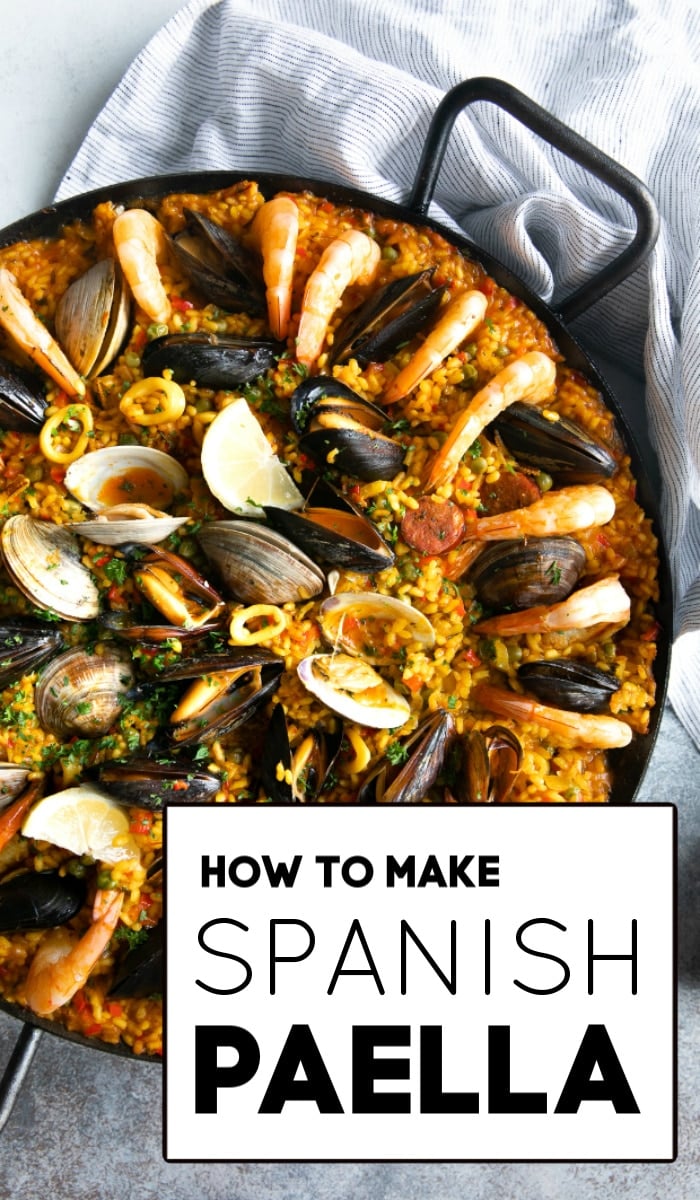
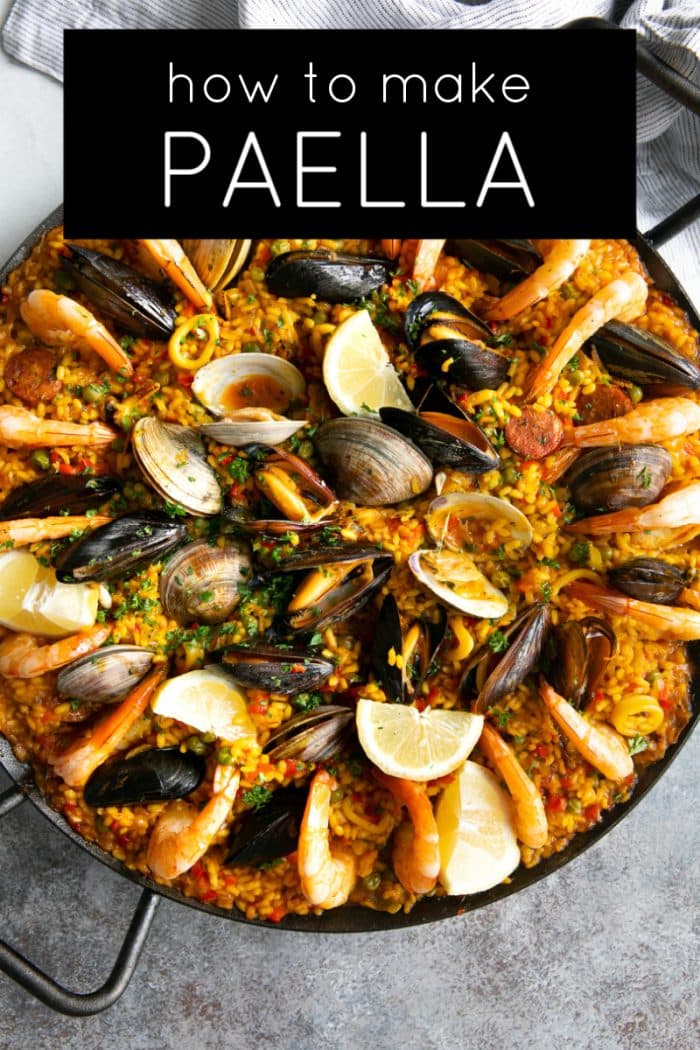
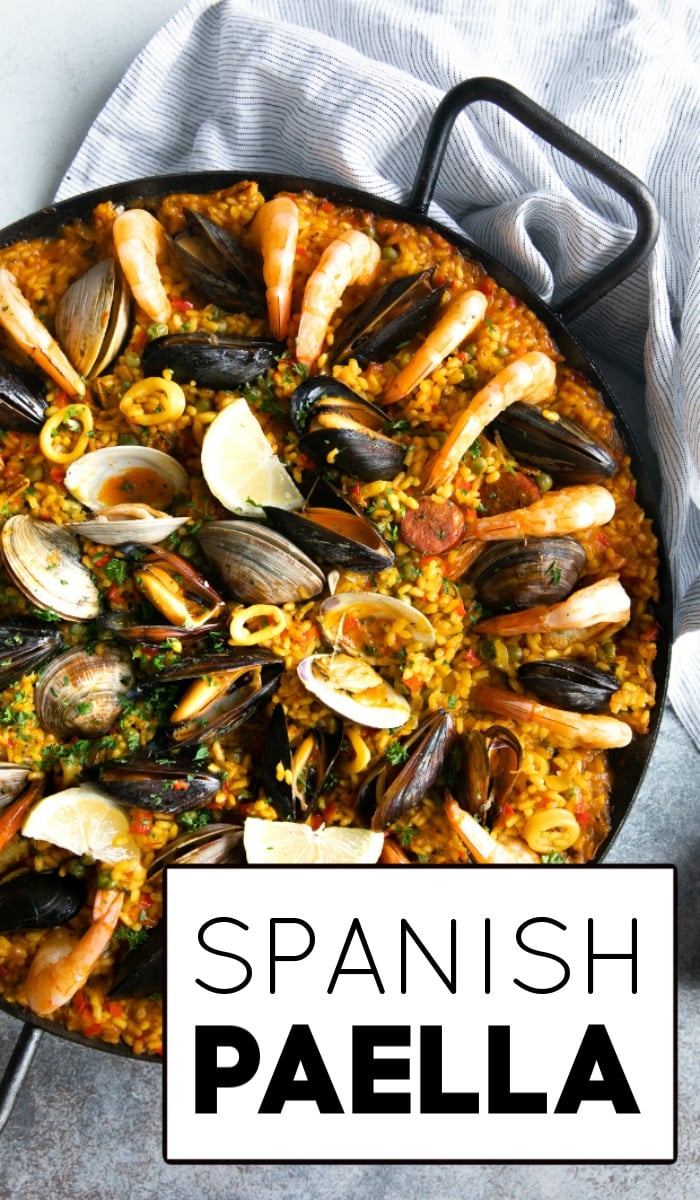
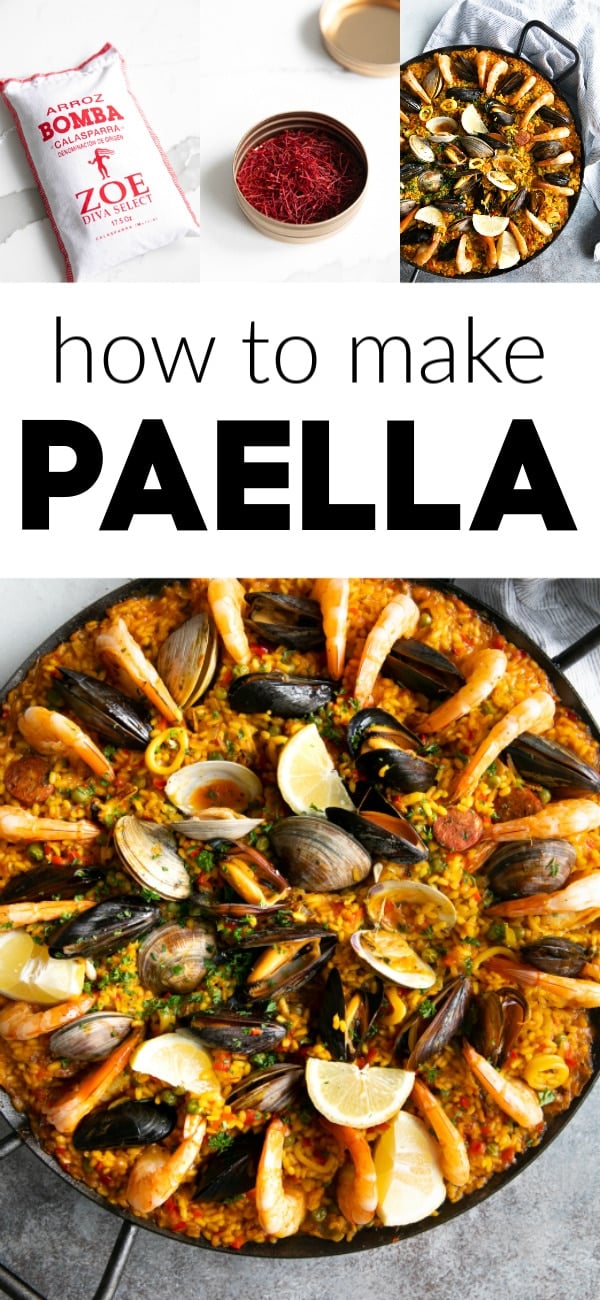

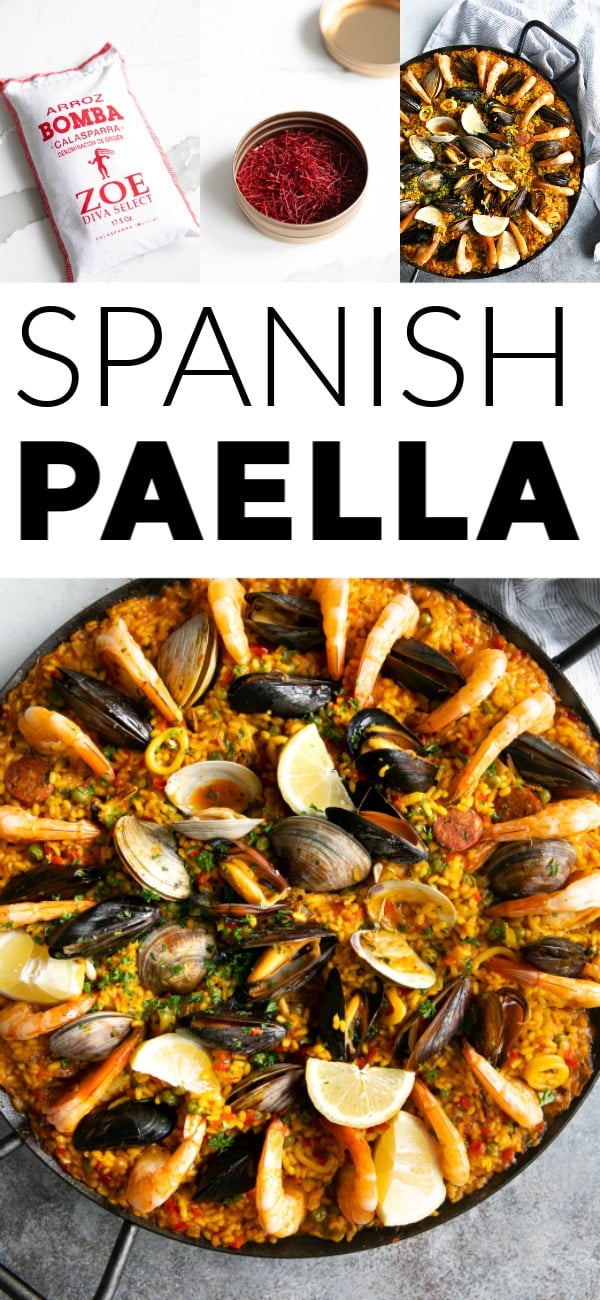

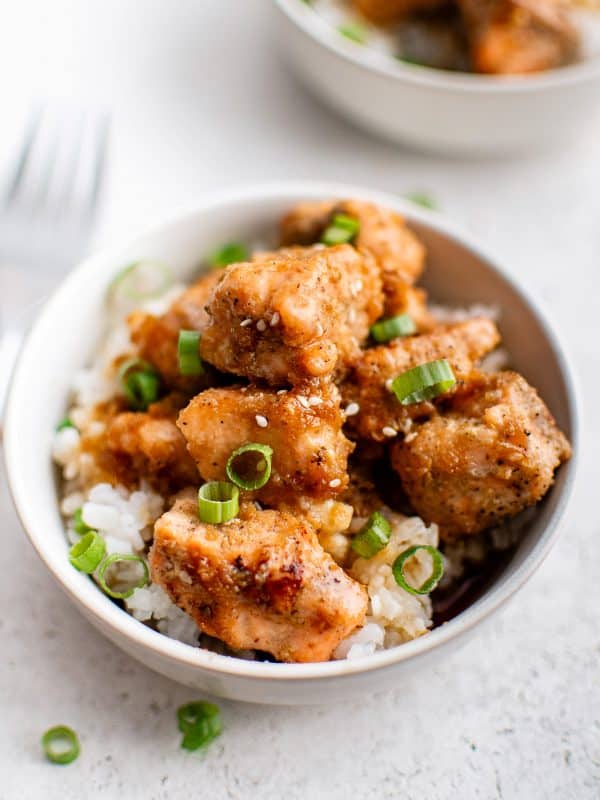

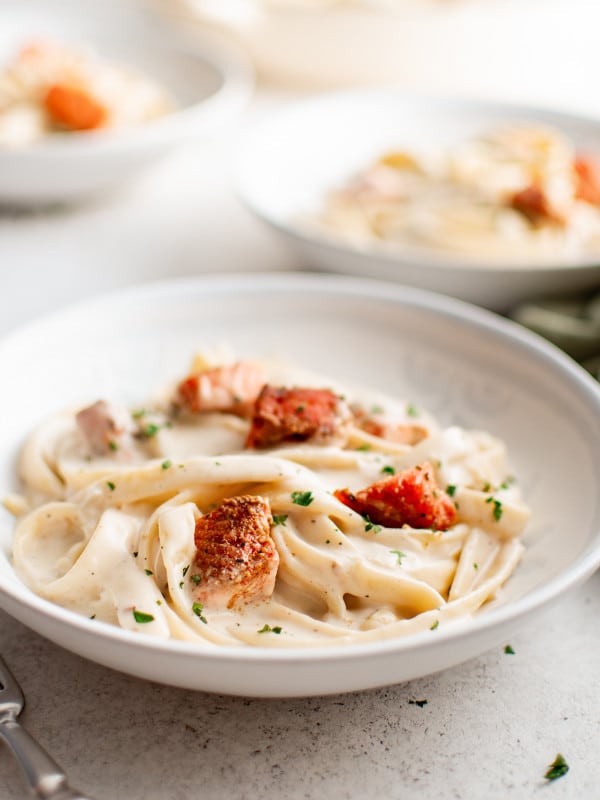
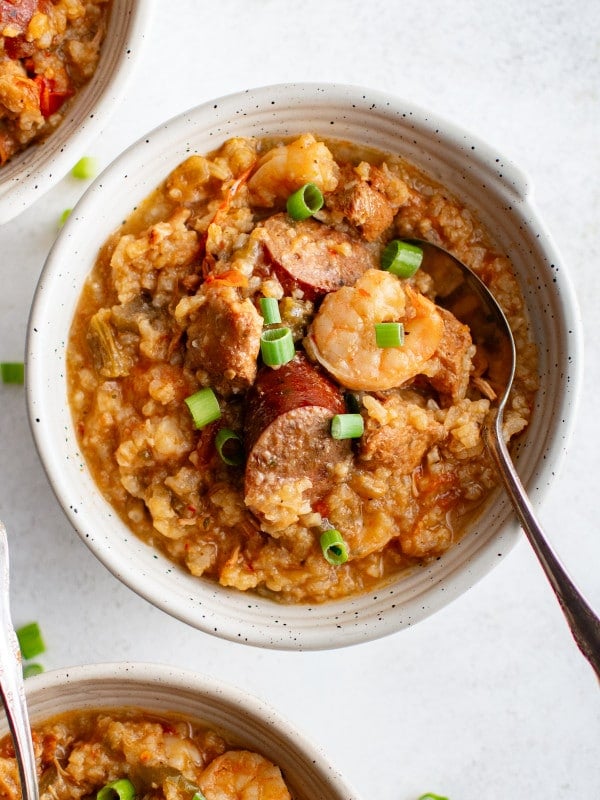








I made this recipe using my new Spanish propane paella burner and 18″ enameled pan. The only changes–I used smoked paprika instead of sweet and doubled the amount, I added chunks of cod and scallops, but deleted clams. I made the shrimp stock and instead of wine added 8 ounces of clam juice. I tasted the clam juice before adding it, it was weak stuff and expensive, surely there is something better in the world. If not, I would just use more chicken stock instead, or the wine. I salted the liquid until it was just right before adding it to the rice.
Also, I did not precook the shrimp, but instead added them to the rice about 10 minutes before I thought it would be done, which turned out to be about 15 minutes, more than enough to cook them. The “herb blend” added flavor, this is unique to this recipe, not found in any others I examined.
The paella came out great, although the rice was slightly burned in the center. I need to turn the center ring burner down relative to the outside ring burner. I will calibrate that with an empty pan using my non-contact IR thermometer to make sure that the whole pan runs at the same temperature. I should have done this first thing, in retrospect. Unfortunately, the gas control knobs on the burners have no indices, so I will have to count the turns of the valve and write down the measured values–room for improvement in the design, definitely. My methods of testing for the “doneness” of the rice need improvement, and nothing I have seen online really seems like the perfect way to do this once browning of the rice starts, so some experimentation is in order. I already have some ideas.
Based on our dinner for 4, this was sufficient to feed at least 8-10 people.
I followed your recipe really closely. Tasty! Your tips were very helpful. I modified the recipe. I put chorizos, chicken, chicken drumsticks and shrimp instead of seafood. I also finished off the presentation with sparingly sprinkling sea salt flakes over the paella. 👌🏻
Thanks for the great feedback and tips, Chary 🙂
I had gotten a paella cooker a while ago, but was too intimidated to try it. Your recipe was so easy to follow and reminded me of the paella we had in Barcelona! Thank you so much for sharing this recipe. I will definitely be making more of it!
Thanks for the great feedback and rating, Cherie 🙂
I read through the recipes a few time, but I do t see when to add the Saffron?
Please see step 5 in the recipe card above 🙂 :
”
5. Combine your stock. Once your homemade shrimp stock has been strained and measured, transfer the desired amount (in my case, I used 4 cups) to a medium stockpot with 2 cups chicken broth and 1 cup white wine (you need 7 cups of liquid total). Bring to a gentle simmer over medium heat. Add the saffron, mix well to combine, and reduce heat to low. Cover and gently simmer until needed.
“
I will be making this for our family Thanksgiving and I’m super excited! I will be using calrose rice and reading your notes it says to decrease the total of liquid to 4 cups. Your recipe says 7 cups total (4 shellfish stock, 2chicken stock and 1 cup dry white wine.) What would you recommend if I need to decrease to 4 cups or should I keep it at 7 cups. Thank you!
When substituting Calrose rice for Bomba rice in paella, it’s important to adjust the liquid ratios because Bomba rice absorbs more water than Calrose rice. Bomba rice can absorb about three times its volume in liquid, whereas Calrose typically absorbs less, about twice its volume.
Here’s what you can do:
Maintain the proportion of the different types of liquids (shellfish stock, chicken stock, and wine) to keep the flavor profile similar.
As you cook, monitor the rice’s texture and doneness. If it seems to need more liquid as it cooks, you can add it in small amounts.
Remember that paella should have a dry, slightly crispy bottom layer called socarrat, and the rice should be al dente, not soggy or creamy like a risotto. Keeping an eye on the cooking process and adjusting the liquid as needed will be crucial to achieving the right consistency with the Calrose rice.
What kind of chorizo?
Spanish chorizo. If you can’t find any Spanish chorizo, try using a different smoked sausage, like Andouille sausage, as it is already cooked.
It was well worth the effort!